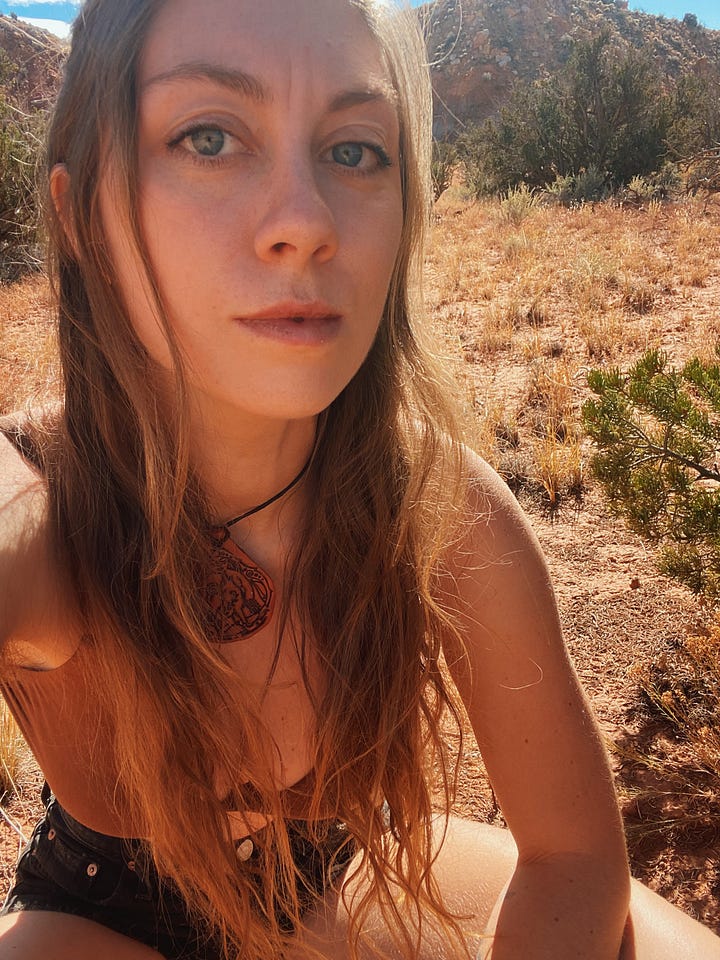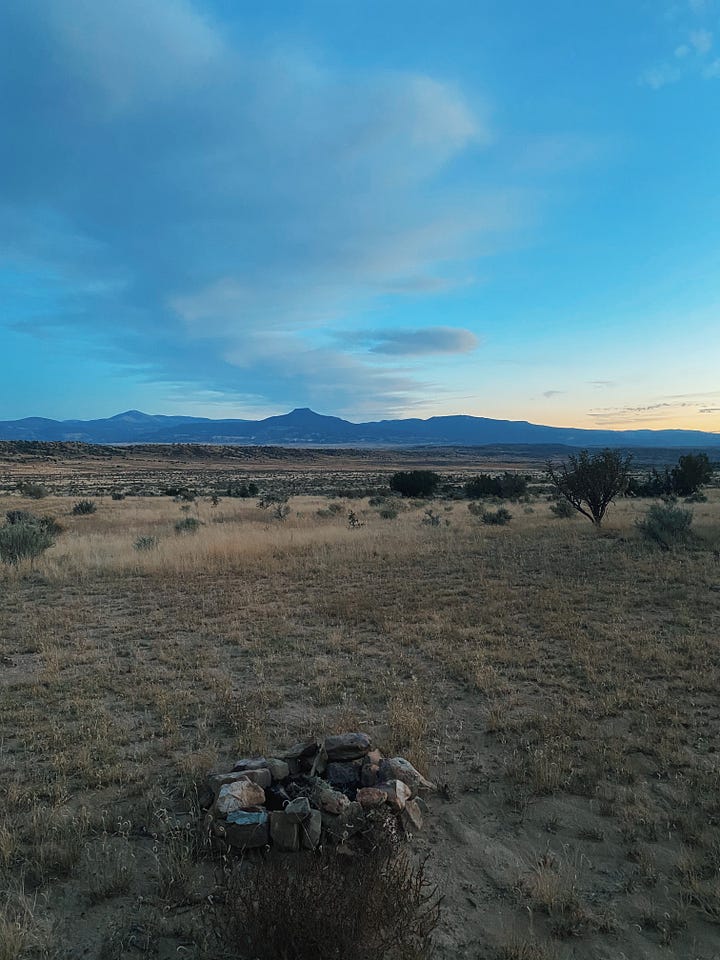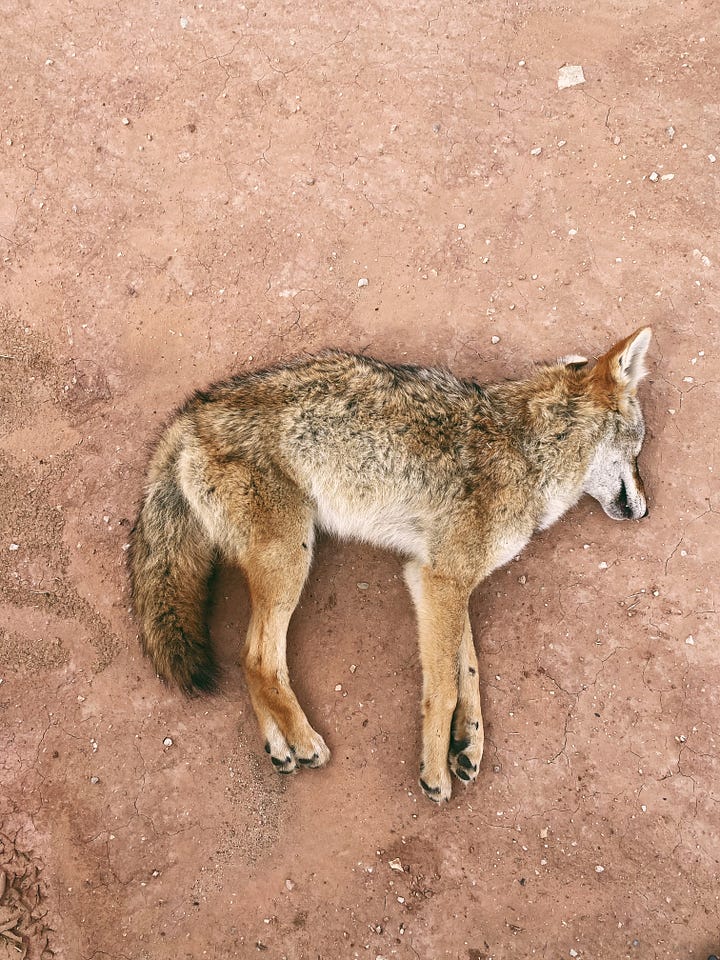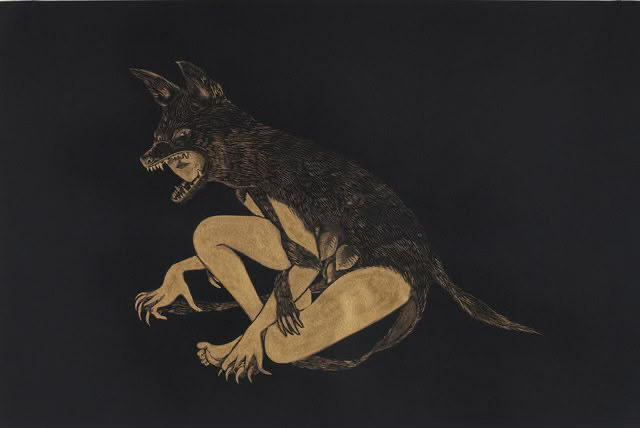what do you hunger for?
coyote, eros, and the desert
Exactly thirteen moons ago, when the sun was last at their zenith and the days were long and languid, I dreamt of Coyote.
To protect the integrity of the dreaming and the dreamt, I will only share the closing scene of the dream.
In this final chapter, I lay in my bed sleeping when a rustling outside woke me. I rolled over to see Coyote moving silently through the mesh that hangs over the sliding doors to the deck that I keep open all summer. In their mouth, limp and soft, a baby bobcat nestled between ivory clasps of tooth.
The coyote's eyes were pale yellow, like two full moons peering back at me.
They drop the bobcat at my bed, sit back on limber hind legs, and stare.
They open their mouth and ask,
“What do you hunger for?”
I awoke abruptly, adrenaline spilling through my blood and turned over to see a small rabbit with their neck snapped at the foot of my bed, lying exactly where the coyote sat. I assume it is a gift from my cat but the similarity startles me. My stomach growls theatrically. And I feel a deeper growl, a growl beyond the physical, echo within.
I spent the next few weeks mulling over the dream and the ever present feeling of hunger that filled me. Whether it was always there unnoticed or it grew after the dream, I couldn’t tell you, only that suddenly, I was acutely aware that I hungered for more.
“What do you hunger for?”
Weeks went by and the gnawing in my soul continued. I rolled the question around in my mind back and forth like waves on stone.
Where was I afraid to own the monstrosity of my desire?
Where was I making concessions, settling for less, playing it small?
This hunger was so unacceptable to my mind that it had been relegated to the Shadow Lands of the subconscious, left to whimper in darkness.
More.
Everything in my life was suddenly squirming on the rust stained butchers block. Everything was to be Marie-Kondoed, picked up, examined, questioned.
I liked my life, didn’t I?
I chose this life… didn’t I?
What was I too afraid to ask for, lest the disappointment in not receiving it crush me?
Where was I too afraid to take up space, lest the rejection leave me wounded?
The question is never how did I get here. It is easy enough to psychically retrace our footsteps through the woods and see the people who hurt us and how life molded us into the shapes we come to hold. It is much harder to see how to get there. To the other side, to the place where desire leads us.
How do we find our way back to desire, to a life not merely inhabited, but lived?
Last autumn I fell in love again, for the first time in a long time.
Not with a person, but with a place.
There's a part of me that didn’t come home from the desert. She is still out there, sitting beside the raven on a juniper branch and dancing through the arroyos with the wind. She waits poised, stuck in the throat of a coyote, until their joyful croon sets her free to rest in the crook of the cottonwood, roots drinking up the river.
She didn’t want to leave, and now, like a horcrux, she remains, sworn to the land that gave her new life under skies wide enough to hold all of her vastness.


It was dawn and the desert was a blanket of sparkling, iridescent white as I awoke to below freezing temperatures in the back of my truck. Crawling out from my nest of sheepskins and down, I made coffee with frozen hands and watched the cup steam into the crisp air. Snow clung to the carmine cliffs and revealed cloven tracks through the sagebrush. I was to drive north from New Mexico towards Utah.
I awoke that morning with the memory of a lone howl in my dream. It lingered with me longer than most fleeting dreamtime fragments. Unbeknownst to me, I had slept that night a few miles outside of a town called Coyote. When I drove through the next morning, I felt it was an auspicious sign.
There was no traffic on the roads, and I left the radio off, listening to the rhythmic hum of the road and the heater in my truck as I drove. I could’ve driven north up through Colorado, but something pulled me east, towards the Badlands.
The Bisti Badlands feel other worldly. Swirling sandstone morphs into curvaceous shapes and spires. There is a ghostly, spirit rich scent in the air, like all threshold places that are thick with transcendence. It was in this thick air that I found Coyote.
In my time midwifing death, I’ve seen an animal's spirit leave its body right away, and other times felt them stick around for a while. As soon as I touched her, I could feel her presence close. I scooped up her soft, still warm body off the side of the road and gently placed her in the back of my truck.
I drove for a bit, away from the highway towards BLM land. There are many people who loathe coyotes. They look at them and see a story of domination and hate. But when I look at her small body, her winter coat dense and thick, all I see is beauty. This perfect, beautiful creature.
In that quiet, still morning, cradled in a sandstone embrace of blooming blush, we entered into ceremony together. I wept for her short life. I sang as I buried her bones there and salted the hide, leaving a ring of salt atop the earth with seeds of datura. I named her Bisti.


“Coyote power: surviving by one’s own intelligence and wits when others cannot; embracing existence in a mad, dancing, laughing, sympathetic expression of pure joy at evading the grimmest of fates; exulting in sheer aliveness; recognizing our shortcomings with rueful chagrin.”
- Dan Flores
In Dan Flores’ Coyote America: A Natural and Supernatural History, he tells the story of one of the most vilified mammals on the continent, and how despite the extermination campaign determined to wipe them out, they continue to not only survive, but thrive.
An estimated half a million coyotes die every year, led by federal agency Wildlife Services, big Ag, and gleeful hunters. They are shot from helicopters, left to die in leg hold traps, or poisoned.
In spite of these horrors, the Coyote persists. They show exceptional skills of adaptation and evolutionary flexibility. Flores writes that, like human animals, “coyote young have lengthy childhoods during which they learn from their parent’s cultural skills and critical information about the world.”
He explains “Coyotes have been in North America far longer than we, they are not going anywhere, and history demonstrates all too graphically that eradicating them is an impossibility." In response to their attempted annihilation, coyotes began having larger litters, changed behavioral patterns, and seemed to shrug their shoulders and laugh in the face of those that would destroy them.
Poignantly, Flores concludes that “all along, Coyotes have been saving themselves.”
Recently I was at my parent’s house looking through a box of old art and stories I'd created as a child. I was shocked to find a number of my own original “coyote tales” written out in childish scrawl. I still remember the first time I saw a coyote. I did not feel the horror or resentment that emanated from the adults around me, only curiosity at this animal that seemed to defy categorization as they slipped easily through the cracks of the known and the wild.
Coyote is the main character of many American folktales across turtle island from Canada to Mexico. Coyote is the classic trickster archetype, meaning they are neither good nor bad, sometimes the hero and sometimes the villain. Often Coyote stories are told as a warning of how NOT to act - other times Coyote is the teacher.
What strikes me most about coyote stories is Coyote’s role as a Creator, shaping the lands and people who dwell there.
This is how Coyote comes to me, as a rule breaker not for spite but for reclamation. They show up as an anarchist and visionary who will push you to build something new, to think outside of the box, to find your freedom. Coyote forces me to question everything, noting that often all is not as it seems.
Coyote doesn’t let me lie to myself. Coyote pulls back the bandage and licks the wound. Coyote doesn’t want me satiated, they want me hungry, hunting, opening, becoming. Coyote will not tolerate a life half lived. They laugh in the face of doubt. They are a dare incarnate. Coyote loves an underdog. Coyote tears up the furniture because we never liked it anyway. Coyote snarls and bites the hand that gives advice that while well meaning, would be better given to Horse or Toad.
Coyote wants me to live.
In the year since Coyote asked me that question, my life has been entirely rearranged. It has been a messy, terrifying, and liberating journey. Every one of my worst fears came true and I am still here. I am not the same woman I was then, forced to strip away the very foundations of my life in order to build something new.
I feel that hunger still, in the caverns of my belly and I am not afraid. I lean in to my longing. I say yes, give me more.
Recommend Reading:
Coyote America: A Natural and Supernatural History by Dan Flores
Prodigal Summer by Barbara Kingsolver
Coyote Stories by Mourning Dove




